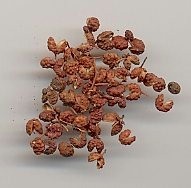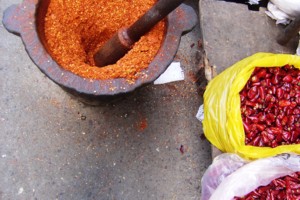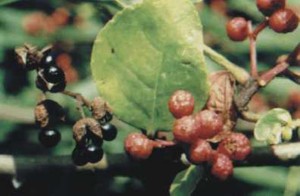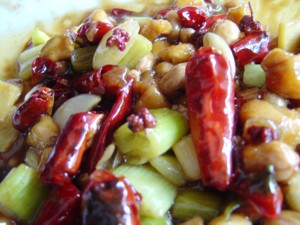The Tongue-Numbing “Flower Pepper” of Sichuan Province
by Kimberly Dukes

Even on a hot, late-summer night, I was sweating more from the spices than from the heat–and so was everyone around me. It was my first taste of hot pot on this trip to China, and I eagerly dipped my chopsticks into the pot and pulled out a tender morsel glistening with spicy oil. My mouth and tongue began to burn. My eyes teared. With every bite, I got hotter: my tongue went numb, my lips tingled, and sweat poured from my forehead. And yet, I couldn’t stop. Chopsticks akimbo, I went back for more.
That night of hot pot convinced me to find out more about what Sichuanese call “hot and numbing” flavor. In the United States, we know chiles well. But Sichuan cuisine adds something special to the heat of chiles: a curious tickle on the tongue brought by the unique Sichuan “peppercorn,” also known as fagara.
Not hot like other peppers, Sichuan peppercorn imparts a tingling numbness that enriches other fiery tastes. In fact, it isn’t really pepper at all. Dried, it looks like dark brown peppercorns, but the “peppercorns” are actually the aromatic berries of a tree related to the prickly ash. Their rust-colored husks open up like blossoms to reveal a tiny seed, earning it the Chinese name hua jiao, or “flower pepper.”

While cooks all over China are specialists in balancing the five flavors of Chinese cooking (salty, sour, spicy-hot, sweet, and bitter), in Sichuan, “numbing” often takes the place of bitter. According to Chinese medicine, if the body becomes internally damp, the body’s yang energy is reduced. Imbalance and illness can occur. In Sichuan’s damp climate, people consider that foods like chiles and ginger help heat and dry the body–and they say that Sichuan pepper’s numbing quality lets you eat even fierier food. This means that even on sweltering summer nights, sidewalk restaurants are full of cheerful patrons feasting on blisteringly spicy hot-pot.
During ten months of living in Sichuan, I grew to crave the pungent, numbing peppercorn. I ate across the province, from its laid-back, crowded capital to small country towns, seeking dishes with the spice. These range from the mild but flavorful–like shoestring potatoes dusted with pepper-salt–to the scorching–like chunks of spicy beef accompanied by a bowl of fire to roast them with.
As I grew more fascinated with the characteristic flavors of Sichuan province, I wanted to learn more about how the peppercorn is grown. Chinese farmers cultivate pepper trees, though some chefs claim wild peppercorns are stronger and taste better. The berries are harvested during the hot summer, in late July and early August, and dried in the sun.
I didn’t want to wait for summer. My husband and I went into the spring countryside in search of Sichuan pepper trees. In Damba, steep mountains surround green hillsides. Orderly fields, striped with rows of barley and other crops, surround the traditional stone houses of the area. Ancient towers jut up from hillsides. Dirt roads wind up the mountain, with steep trails connecting the roads to scattered houses.

The farmer stopped at her line of trees, edging a barley field. Smiling, she pulled a branch down towards us. The berries were a bright, pale green, clustered in what look almost like flowers from a distance. She brushed her fingers over the berries and then brought her hand to her nose. I copied her, breathing in the unmistakable aroma of Sichuan pepper despite the youth of the berries. At her house, she offered us water, introduced us to her mother, and brought us into her storeroom to scoop up handfuls of dried peppercorn, putting some into a bag for us to keep.
I knew I loved the taste of Sichuan pepper, and now I knew how to identify the peppercorns. But I wanted to learn how to cook with hua jiao. In Tagong, a Tibetan cultural area in the mountains of Sichuan province, a close friend was happy to let me watch her cook. Wu Fan owns a small and popular restaurant near the town square. These were cooking lessons like no other. She chopped like the wind, set oil to heat in her large old wok on her single burner, dipped ladles in and out of the wok, and darted spoons in and out of tiny spice boxes, chatting all the while about other matters. I scurried back and forth interjecting questions, trying to time cooking stages, and scribbling down what Wu Fan had just done while watching what she was doing now.
Cooking with Wu Fan and other friends, I found that “How much do you use of this spice?” and “How long do you cook that pork before doing the next step?” were impractical questions. In Sichuan, you learn to cook by watching, by tasting, and by cooking, not by numbers.
After meticulously chopping vibrant green and red peppers, he simply tossed a good handful into the wok while his students scribbled in their notebooks. Back in the United States, I took out my treasured bags of Sichuan peppercorns and practiced developing some more cooking intuition. Long banned here due to fear of importing pests, Sichuan peppercorn is now legal and easily available. American cooks who sought out smuggled spices a few years ago–or who tried to substitute other pepper in Sichuan recipes and were disappointed–can now experiment with new recipes and freshly imported peppers.
I found that Wu Fan and my other friends were right. Without recipes, I had to remember the tastes I craved and strive to create them by balancing ingredients and improving the dish every time I tried it. I discovered I could fashion delicious Sichuan “hot and numbing” food in my own kitchen, even without identical vegetables or other ingredients.
Even more, though, cooking like this gives me practice in remembering Sichuan itself. Chopping and tasting, I think of laughing with friends in a crowded, noisy city restaurant, happily sweating alongside other contented eaters. With a trial bite, I remember brushing my hand over fresh pepper-berries, standing in the sun and listening to a tiny tractor chug along a dirt road. And I think: I’ll have to try this dish again.
Note to Cooks
If you are not using a wok or are unfamiliar with stir-frying in a wok, be extra careful not to burn the spices. Try putting the chiles and Sichuan peppercorn in when the wok or pan is medium hot, and lift it off the heat to adjust the cooking temperature. Another note about wok cooking: it’s always best to “season” the wok every time you cook. Heat a little oil in the wok and swirl it around, then discard, before putting in the oil you will cook with. This helps prevent the food sticking to the wok surface.
Sichuan Pepper-Salt
In Sichuan, this pepper-salt can add zing to almost anything. Try it as a general seasoning in marinades for meat and chicken, or sprinkled on fresh popcorn. Note: Remove any twigs or thorns found in the Sichuan peppercorns before toasting.
Tongue-Numbing Spicy Beef
The chef who demonstrated this recipe called his version “Fire Beef,” not because of the spice–which he took for granted–but because he accompanied the platter of beef with a small bowl of solid alcohol, lit with a match, so diners could toast pieces of beef over the fire at the table. The numbing Sichuan peppercorn complements the heat of the chile; experiment with the balance of hot to numb if you’re adjusting the amount of chile to your taste. Because this is a stir-fry and must be cooked quickly, do all your chopping and measuring before starting to cook. Note: Like the following dish, this is best eaten with chopsticks.

This is an immensely popular dish that you can find in nearly every restaurant or home. I like the crunch of crisp American celery with the chicken and peanuts. Play with the recipe by replacing the chicken with shrimp or tofu, or by replacing the peanuts with cashews to dress it up a bit more. If you use peanuts, look for “Spanish” peanuts, which still have their reddish skins. In Sichuan, “facing-heaven” chiles are used in spicy dishes. They add visual appeal as well as flavor, but if you can’t find these, substitute other peppers that are medium-hot and richly flavorful. Here I use small Japanese chiles easily available in most supermarkets. Note: Because this is a stir-fry and must be cooked quickly, do all your chopping and measuring before starting to cook.
Peppered Tofu
Even if you think you don’t like tofu, try this simple and tasty dish! This recipe comes from Wu Fan, the owner of a popular restaurant in Lhagang, a small town in Sichuan province. This is one of Wu Fan’s favorite “homestyle” recipes with Sichuan peppercorn. It’s not very spicy, but you could experiment with adding Sichuan pepper oil, chile oil, or hot chiles to increase the heat scale. Accompany this dish with a snack of boiled peanuts, rice, or vegetables, or serve it alongside spicier dishes to create a balanced overall flavor.
Spicy Spinach
In Sichuan, this simple technique is often used to cook a vegetable usually translated as “empty-hearted vegetable.” If you live near an ethnic grocer, you may be able to find this vegetable, but if not, try this recipe for the spinach more easily found in in the United States. The hot-and-numb flavor also suits many other green vegetables–try it with broccoli. I used small Japanese chiles here, but almost any chile should do; adjust the spiciness to your liking. Note: This may seem like a lot of fresh spinach, but it will reduce as it cooks.




